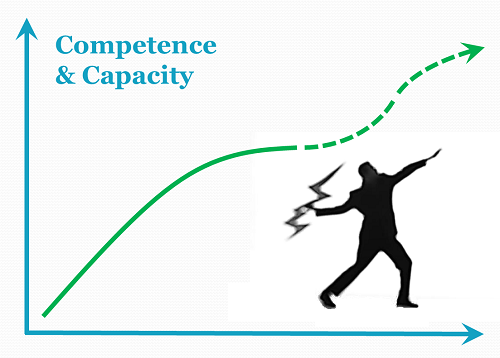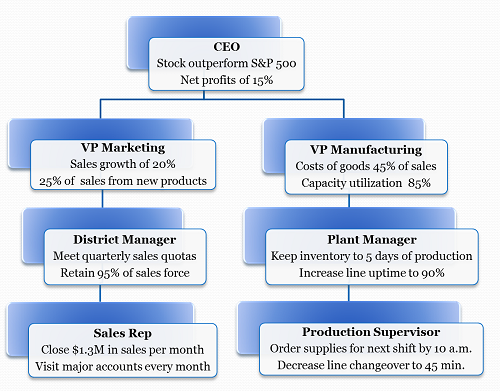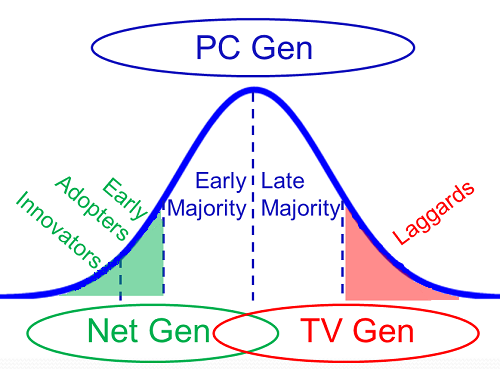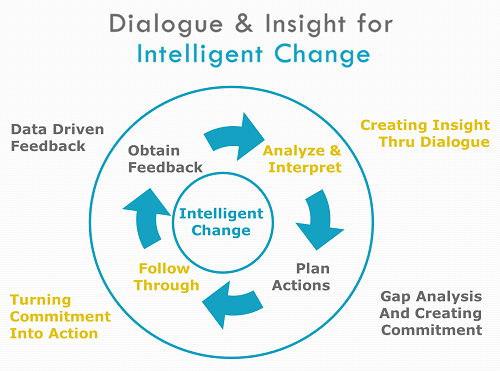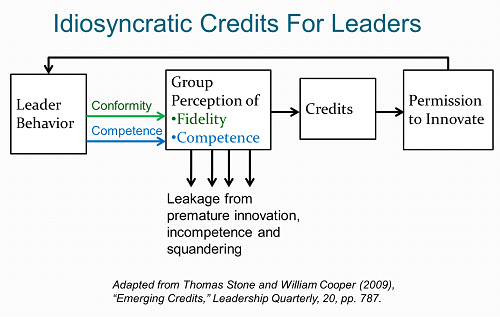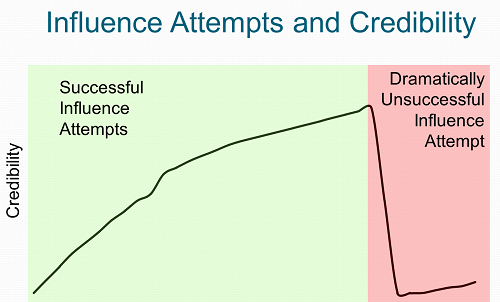When you walk in the room, who shows up for Read more →

Pausing on the Performance Plateau
Allen Slade
As you transition into a new job, sense-making takes time. Your performance suffers as you figure out the who, when, where and how of your new role.
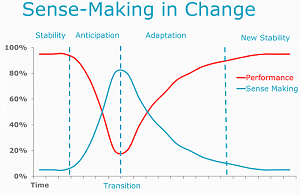 As time goes by, you adapt to the new situation. Your job becomes more predictable. As you enter the new period of stability, your sense-making lessens and the red line of performance flattens out.
As time goes by, you adapt to the new situation. Your job becomes more predictable. As you enter the new period of stability, your sense-making lessens and the red line of performance flattens out.
And that is when you must be most careful. Having mastered the new role, you can get complacent. Feeling you already know what you need to know, you can slow down your personal development. Your performance can get plateaued.
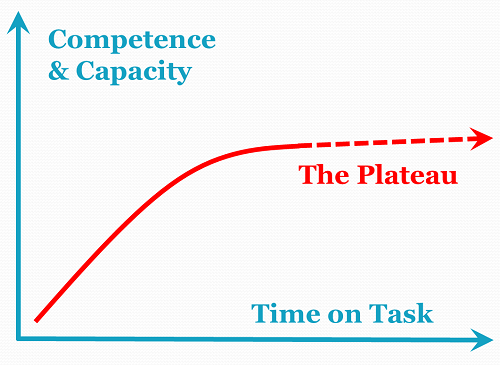 The further we go in life, the more likely we are to find ourselves on a performance plateau. Here are some warning signs:
The further we go in life, the more likely we are to find ourselves on a performance plateau. Here are some warning signs:
- Stays in the same role for three years or longer.
- Loses the hunger for the next big thing.
- Resists change actively and passively.
- Gets defensive about feedback.
As a leader, you need yo watch out for the plateau effect for your employee. Since the rate of economic change is accelerating, they must master new competencies and expand their capacity to work faster and longer. Faster change is their only sustainable comptetitive advantage. Otherwise, they will be replaced or drag your organization down.
Bottom line: Treat a performance plateau as a warning sign and take action. Here’s how to trigger growth to get your people off the performance plateau.
Add new challenges. If someone is great at sales, have them take on social media. If someone has mastered six sigma, ask them to apply it in another department.
Rotate roles. Don’t always give the task to the best person for the task. You may formally rotate jobs, even for people with decades of experience. On a smaller scale, rotate responsibilities. Have your experts work outside their specialties. The database guru can plan the next meeting and the meeting planner can build your new database.
Develop their openness to feedback. Openness to feedback is the single most important trait your employees can develop. If an employee has the defend/deny/delay response to constructive criticism, coach them in accepting feedback. You can open them up to lifelong growth.
Don’t be content with stable performance. Help your people get off the performance plateau. Trigger growth with new challenges, rotating work and openness to feedback. Then, you will prepare them to charge ahead into the future with an upward curve of competence and capacity.
Management by Objectives? Or Leading with Goals?
Allen Slade
Here is a simple recipe for a post on a leadership blog:
Are you doing bad things too much? Do good things more. You and your employees will prosper. Your comments welcome below. And follow us on Facebook!
Here are some leadership contrasts that fit the recipe:
| Bad Things: | Good Things: |
| Managing | Leading |
| Controlling | Empowering |
| Commanding | Engaging |
| Reacting | Anticipating |
If today’s topic is “Management by Objectives? Or Leading with Goals?” we probably agree that it is better to lead people than to manage objectives. As a society, we value leaders and leadership. That’s one reason I am a leadership coach, not a management coach.
Hang on, it’s not that easy. The best leaders are good managers, too. Empowerment requires controls (like accounting and scorecards). You need to engage, but in a fire, you need to command. And, you need to react to what no one could anticipate.
Bottom line: If you are a leader, you may need to use Management by Objectives. And, as a manager, you should Lead with Goals. Let’s take a closer look:
Leading with Goals is a powerful tool for influence. As a leader, have a goal setting conversation with each employee at the beginning of the year. Encourage them to set SMART goals. Use those goals for continuous improvement throughout the year. And use those goals as the focus of the performance review at the end of the year. Make sure each employee has at least three goals but not so many goals they are overwhelmed.
Management by Objectives is a bit different. In MBO, managers assign every individual a specialized set of objectives or goals. Performance reviews are conducted periodically, and rewards are given to individuals based on performance against goals.
MBO combines the motivational power of goal setting with the coordination power of strategy formulation. MBO systems create a cascading set of goals.
The CEO has goals that cascade to the VPs. Their goals cascade down through their functions. If all goals are met at one level (meet quarterly sales quotas), you should meet the goals at higher levels (sales growth of 20%).
So, which is better? Management by Objectives or Leading with Goals?
Research indicates that goals increase performance. When employees participate in setting their goals, they have higher commitment to the goals. So, with MBO, the top-down goals may undermine motivation somewhat. Leading with goals, so long as you use participative goals setting, will increase performance a bit more more. Still, top-down goals are better than no goals, so MBO is better than nothing.
Furthermore, MBO is better at cross-group coordination than purely participative goal setting. At the extreme, set-your-own-goals can lead to organizational chaos. If Marketing sets stretch sales goals, but Manufacturing sets quality goals rather than capacity goals, you may sell more than you can make. MBO provides the advantage of linking all goals to each other and to the organization’s strategy.
My advice to those at the top: Don’t think either MBO or Leading by Goals. Do both well. Maximize coordination power of MBO by linking goals throughout the organization while maximizing the motivational power of goal setting by engaging employees fully.
One way to do this is the double cascade. Strategy formulation starts at the top and is cascaded down. Then, all levels give feedback on the strategy. Next, preliminary goals are cascaded down. At every level, employees and managers sign up for SMART goals and give feedback up the chain. This extra round of two-way communication and coordination increases the quality of the decisions made and ensures that the resulting goals will gain traction throughout the organization.
For managers in the middle, your company either has management by objectives or it doesn’t. You probably have little say in whether goals are going to be cascaded down to you.
In an MBO organization, your key move as a leader is to act with integrity as you engage your employees. If you have been assigned goals by your leadership, let your team know. Empower them to help you find the best way to accomplish your goals. Find areas of wiggle room for them (often in the how and when of performance) so that they fully commit to your plan.
In a non-MBO organization, get your people as coordinated on goals as need be. If there is a high level of interdependence, do team goal setting. If there is some need for coordination, be the communication linchpin for goals. If there is little need for coordination, don’t waste your time.
MBO or not, you can lead with goals – SMART goals, goal-driven continuous improvement and goal-focused performance reviews – to maximize the engagement of your employees and the success of your organization.
Leading Change for the Net Gen, PC Gen and TV Gen
Allen Slade
In a post on Digital Deception Detectors, I contrasted two views of technology:
The Net generation integrates technology fully with relationship. They adopt new technology for coolness, using Facebook (or Twitter or Pinterest or whatever) because their friends do. Using a network multiplies their friends on the network.
The PC generation sees technology as a tool. They master new technology to get things done. They aren’t early adopters. They won’t upgrade Windows or switch from email to Facebook without a good reason. They want a tested version of new technology, with no bugs and a good help function.
Here’s a third perspective:
The TV generation passively accepts what technology offers. They change the channel or dial the phone, but they allow other to create the channels and content. If technology does not work, they look for an expert or give up. They tend to be late adopters, mastering new technology under direction or duress. Once they have mastered a technology, they use it habitually.
Geoffery Moore categorizes people by how quickly they accept new technology – from early adopters to laggards.
The difference between Net, PC, and TV generations is not necessarily how quickly people adopt new technology. The difference is how and why people use technology. The Net gen asks “What’s cool? How can I connect to friends?” The PC gen asks “What works? How can I get stuff done?” The TV gen asks “What’s on tonight?”
As a change leader, how should you interact with the three generations?
The Net generation treats technology as a natural part of life. They can be the easiest to lead becasue they are are comfortable with technology change. However, they can be cynical about large organizations and their leaders. Their digital deception detectors are tuned for any sign of inauthenticity.
Microsoft’s old advertising slogan “Where do you want to go today?” worked well with the PC gen, but the Net gen’s reaction was “Riiight. Bill Gates, the richest man in the world, wants to help me accomplish my goals.” Trip their digital deception detector and you’ll lose the Net gen.
The PC generation has a utilitarian relationship with technology. They would rather not upgrade to the latest version of Office or change from email to Facebook unless there is a good reason. When getting their buy-in, leaders should focus on the great things they can do with the new system.
When we converted to a new web-based survey system at Ford Motor Company, our audience of executives and HR professionals were largely PC gen. Our key message: Better, Faster, Cheaper. We reduced turnaround time and costs, music to the ears of the PC gen.
The TV generation has a passive relation with technology, expecting to absorb what is transmitted. They can resist learning new technology that requires their active involvement. The TV gen may require a lot of persuasion, to the point of coercion.
One of my colleagues launched an executive information system restricted to vice presidents (no executive assistants allowed). One third of the vice presidents never logged on. They want their reports delivered to them, like turning on the television. The CEO decided to guide the non-users to leave the company as soon as possible. My colleague’s take “If you can’t change the people, sometimes you have to change the people.”
Bottom line: You can lead change across the generation gaps. For the Net gen, be authentic. Emphasize the coolness and connectivity of the technology without triggering their deception detectors. For the PC gen, focus on achieving business objectives. Be persuasive about the value of change. For the TV gen, confidently lead the change. This may mean directing the laggards to comply or leave.
Put it all together, and you will have authentic, goal driven and confident leadership of change. That’s the type of leadership all generations can get behind.
How’s Your Digital Deception Detector?
Allen Slade
Catfishing entices a dupe to befriend a fake person, to the victim’s embarrassment. Notre Dame football player Manti Te’o used his girlfriend’s death to propel his team to the national championship game. When this girlfriend turned out to not exist, he claims to have been duped.
Was Manti Te’o a victim, part of the scheme or a little of both? How could credible sports reporters feature this emotional story without checking their facts?
Leaders must be masters of the digital divide that catfishing exploits.
The PC generation sees technology as a tool. They master new technology as necessary to get things done. They tend not to be early advocates of new technology. They would rather not upgrade Windows or switch from email to Facebook unless there is a good reason. They want a tested version of the new technology, with no bugs and a good help function.
The Net generation integrates technology fully with relationship. They may be early adopters of new technology, but they adopt it for coolness as much as utility. Their choice of media is driven by relationships. They use Facebook (or Twitter or Pinterest or whatever) because many of their friends do. And, their use of a network creates more friends on that network.
One of the differences between these generations is how they avoid deception in digital relationships – the problem of Manti Te’o’s nonexistent girlfriend. The PC gen avoids deception by limiting true relationships to people they have met face-to-face. They might think Manti is a fool for having a girlfriend he never met. The Net gen does not limit friendships to the physical world. Instead, they survive and thrive in the virtual world by developing finely tuned deception detectors. They might think Manti Te’o is a fool because his digital deception detector failed.
The PC gen and the Net gen can be hard to tell apart. They both use smart phones and tablets, Facebook and Twitter, Excel and WordPress. And, a 70-year old can be in the Net gen while her grandson is in the PC gen. Manti may be a Net Gen’er who duped PC Gen sports reporters until things spun out of control. Or he may be a PC gen’er whose use of network technology was naïve.
As a change leader, how can you tell them apart? I ask a single question: “Do you have close personal friends that you have never met face-to-face?”
- PC gen: “Are you kidding?”
- Net gen: “Yes”, with active digital deception detector.
- Future catfishing victim: “Yes” but lazy or clueless about digital deception.
As a leader, you must navigate the digital divide between the PC generation and the Net generation with agility and authenticity.
If you are of the PC generation, master the new technology and find friends you will never meet face-to-face. Go slowly to avoid being catfished. Don’t propose marriage but do corraborate any funeral notice. (You can practice with me – Twitter, Facebook and LinkedIn buttons are at the top of this page.)
If you are of the Net generation, bring the PC generation along by appealing to the utility of the networked world. Help them avoid being catfished. Appreciate and honor their desire for face-to-face contact.
Whichever side of the divide is your native land, mediate the conflicting world views with authenticity. Then, you will be able to get everybody on board with your larger purpose.
Coaching for the Long Hill of Change
Allen Slade
Last May, I rode my bike in a century. I had completed 50-mile rides before, but I had never ridden 100 miles in one day. I trained hard, but not hard enough. About mile 60, I boinked. My energy reserves were depleted, and my speed dropped five miles an hour. Halfway up a long hill, I stopped. I had to catch my breath and decide if I was going to finish. I completed the hundred miles, but it was a close thing.
Like the long distance cyclist, leaders must be internally motivated. External praise is rare. The cheers of the crowd are too distant to carry you up the hills. You cannot afford to boink at the 60 mile point.
There are signs of leadership fatigue everywhere. At a leadership conference last week, one of the keynote speakers suggested we give up trying to change large organizations. Several panelists talked about the loneliness of leadership.
Leadership lite is about prestige and power, personal glory and personal gain. Regular readers of this blog know that I do not prescribe leadership lite. In my experience, the challenges of true leadership are large. Change leaders must master the four C’s: commitment, competence, capacity and character. In general, change leaders have to work longer, harder and smarter than the people around them.
I don’t intend to discourage true leaders. You need to have realistic expectations of the leadership challenges you face. But you also need support. You probably will not find encouragement from the people you lead. You may not find support from your peers, especially if you are competing with them for budget, talent or promotions. And, if your own leaders are fully engaged, they may be more discouraged and stressed than you are.
There is hope. You are not condemned to a life of lonely leadership. You simply need to gather the support you need.
Use the support you already have. Reach out to your close friends and family. Engage your circle of trusted advisors. Talk about your challenges and your discouragement.
Once you become an executive, you probably should hire an executive coach for yourself. Even before then, if you are leading change, investigate whether your organization will provide a leadership coach. A good coach will provide real and present encouragement. A coach will also help you find the support you need in others. And, a coach will help you develop the commitment, competence, capacity and character you need to lead change.
Leading change requires you to climb the long hills without much encouragement. Get coaching so you can keep pedaling.
Unlock Your Habits With Data
Allen Slade
Leaders are creatures of habit. We hit upon a successful approach to communication, planning, decision making or hiring and we stick with it. Habitual behavior is very sensible. What worked yesterday is likely to work today. Yet, habits can become handcuffs. Habits may be comfortable and easy, but disaster looms around the corner.
As a leader, how do you know when to change? How do you unlock your habit handcuffs? You need data.
 In the FIRST Lego League robotics competition, my sons’ team collected lots of data. They programed a wheeled robot to run a mission in 2 minutes and 30 seconds. The team spent months strategizing and reprogramming to beat the time limit. Data on the robot’s speed and reliability were key to continuous improvement.
In the FIRST Lego League robotics competition, my sons’ team collected lots of data. They programed a wheeled robot to run a mission in 2 minutes and 30 seconds. The team spent months strategizing and reprogramming to beat the time limit. Data on the robot’s speed and reliability were key to continuous improvement.
As a leader, you need data to know when your habits are ineffective. I advise you to build your own leadership scorecard. Track data on at least four different outcomes. Use a mix of “soft” data (employee and customer satisfaction, 360 data) and “hard” data (sales, costs, productivity and quality). If your organization produces reports for you, I encourage you to create your own leadership scorecard. If your organization doesn’t generate the data you need or if you are an entrepreneur, you may need to collect the data first.
You need to track these outcomes over time. Data from one point in time does not drive action nearly as well as trend data.
Once you have the data, build a spreadsheet or put it on a whiteboard. Avoid data overload by keeping your leadership scorecard focused. It should fit on a single sheet of paper or part of your whiteboard.
Once your scorecard is built, you are ready to start the cycle of intelligent change.
When your habits are not working, your scorecard will show it. Engage your team or your circle of trusted advisors in dialogue. Analyze the data and interpret the causes. Plan actions to fill the gaps and follow through. Then collect more data.
Bottom line: Leaders need to be data-driven. Create your own leadership scorecard to unlock the handcuffs of habit and reprogram your own behavior.
Create a virtuous cycle of intelligent change. Don’t wait for a crisis to look for numbers. Being data-driven should be your new habit.
When Your Personal Brand is Your Business Brand
Allen Slade
The essence of your personal brand is simple: When you walk through the door, who shows up for the other people in the room? As a jobseeker, your personal brand captures the service you are offering to an employer. As a leader, your personal brand is the influence you exercise in driving innovation and growth.
How about entrepreneurs? As the boss, you aren’t a jobseeker trying to nail the interview or an emerging leader trying to get people to start following you. Entrepreneurs are busy with operations, finance and market development, so “personal branding” may seem like a waste of time.
Wrong. Personal branding is vital to entrepreneurial success. When you are an entrepreneur, you are your business. When you market your business, especially in the early years, you are marketing yourself. In many ways, your personal brand is your business brand.
At one of my recent personal branding seminars, a twenty-something woman shared her passion and unique business model. However, she was outfitted and groomed for comfort rather than marketing, undermining her great ideas.
So, who shows up for your prospects when you walk in the room? Do you project the traits necessary to win their business? Here are some hints on developing your personal and business brand.
Be authentic. Make sure your personal brand is completely compatible with the real you. And make sure your business fits you as well. Being authentic ensures you (and your business) will avoid false advertising. If your brand promises what you can actually deliver, you and your customers will prosper.
Project an integrated image. This is Branding 101. Once you have specified your desired brand, review every part of your public image to make sure it is consisted with your brand. Review everything: marketing strategy, service offerings, elevator pitch, brochures, website, blogs, business cards, LinkedIn profile, Facebook page, Twitter profile and tweets.
Test and adjust your brand. Get feedback as you roll out your brand. You want to test an ejection seat before you need it. So test your brand privately before you go public with it. Early on, test your brand with yourself. Adjust your public materials to fit your brand statement, and adjust your brand statement to fit your previously successful public materials. Next, run your proposed brand by your circle of trusted advisors. Hand out business cards to friends and family. Practice your elevator pitch. Ask people what they think. Then, do a small scale public unveiling. Pilot test your newly articulated brand with both prospects and trusted current customers. Get their feedback and continue to adjust until you hit a sweet spot – a brand that is personally authentic and offers compelling benefits to your customers.
At the branding seminar, I offered one more piece of advice:
Dress (slightly) better than your customers. I recommend that you dress one half step better than your customers. If they wear business casual, you iron your khakis and polo. If they wear a blazer, you add a tie. If they have a skirt, you were a dress or suit.
The twenty-something entrepreneur caught the personal brand bug. She emailed the next week about changes she was making in her brand image. “I’m trying to dress more professionally these days. Sounds simple, but for me, it’s really hard. Especially the whole ‘make-up’ thing!”
While you may not struggle with make-up as part of your personal brand, you will struggle. Your brand is the essence of who you are and the value you add to the people around you. Getting it right requires time, energy, thought and feedback. And, when it clicks, you and your business will succeed.
Change in Your Personal Leadership Brand
Allen Slade
It is essential for you to have a personal brand statement. I like this style of brand statement:
For [a specific person or group], I want to be known for [six adjectives] so I can deliver [valuable outcomes].
When my clients ask what adjectives they should choose, I respond “What outcomes do you want to deliver?” For my leadership coaching clients, their outcomes usually include maximizing their influence as a leader.
While working on Ford’s employee opinion survey, the CEO wanted to add questions about empowerment. With Ford’s global operations, we delivered the survey in a number of languages. The word “empowerment” proved tricky for many of our translators. In German, the question “My manager understands how to empower people” came back as “My manager understands how to turn on the lights.” I believe in testing my ejection seat, so we found and corrected the mistranslation before the survey went live.
Yet, too many managers focus on turning on the lights – getting the budget set, scheduling activities, communicating basic information, producing management reports. A light switch operator doesn’t really have a personal brand. They are a commodity.
Your impact as a leader is the scope of influence you can exercise. If you can’t drive innovation and growth, you are just turning on the lights. Could you be easily replaced by another manager? If so, you need a new personal leadership brand.
If you wish to be known as a leader and not just an individual contributor or manager, then your personal leadership brand must highlight your ability to innovate/change/grow a team, an organization or a business.
Yet the best leaders do not tilt at windmills like Don Quixote, attempting (and failing) to do the impossible. The best leaders look for difficult challenges that stretch themselves and their team without destroying the leader’s credibility. Thomas Stone and William Cooper capture the tension between innovation and credibility in the following process:
It is a curiosity of leadership that conformity builds credit for future innovation. Going along now creates the opportunity to innovate later. The “leader” who avoids risk does not spend any credits. The leader who pushes too far too fast burns credits without gaining influence.
If you are not content with being just a manager, you can change your personal leadership brand. Be patient. Becoming an innovative and influential leader takes repeated success over time. When you first step into a job, you start with a small cache of innovation credits. If you spend those credits wisely, building your group’s perception of your fidelity and competency, you gain more credits. Bit by bit, you are able to innovate more boldly, expanding your influence well beyond the range of indifference. In the image below, this gradual increase in credibility, influence and innovation is captured in the green area.
Since true innovation is risky, you may have a dramatically unsuccessful influence attempt that will erase most of your credibility. In the red area above, the impact of a major misstep leads to a resetting of the credibility curve. Many leaders find it necessary to retreat, operate largely in the range of indifference, until they regain the credibility to tackle new challenges. The loss of credibility can be so severe that the leader needs to start over in a new job or a new organization.
Managers who avoid risk will not play this game. They will stay in the range of indifference, never risking their credibility and hoping to never fail. They may or may not fail, but I can largely guarantee that they will not experience dramatic success.
You have a choice. You can create a personal leadership brand involving wise risk taking to create innovation. Or you can create a safe style more appropriate for a manager. You can empower change, or you can just turn on the lights.
My personal choice was made a long time ago. The Slade & Associates brand is “Creating dialogue and insight for intelligent change.” I hope this blog helps create insight for you that will drive intelligent change in your leadership.
Pivot to the Center
Allen Slade
When incumbent presidents run for re-election, they usually win. Of the last 14 reelection bids, 10 were successful. Since 1996, every president has been reelected. Franklin D. Roosevelt’s perpetual reelection led to a constitutional amendment to limit presidents to two terms.
Non-incumbent politicians must capture the partisan base in the primaries. To win the general election, most politicians have to pivot to the center to capture non-partisan votes. The most effective politicial leaders govern for the common good, usually requiring a second pivot even further to the center.
In this presidential election, Obama was able to stay near the center politically. Romney had to execute a difficult pivot to the center. Jacob Weisberg describes Romney’s campaign as a failed pivot to the center:
Romney is not a right-wing extremist. To win the nomination, though, he had to feign being one, recasting himself as “severely conservative” and eschewing the reasonableness that made him a successful, moderate governor of the country’s most liberal state. . . . Romney’s pandering to the base made it possible for the Obama campaign to portray him as a right-wing radical from the start of the campaign. Fear that he didn’t have the base locked down kept Romney from moving smoothly to the center once he had secured the nomination.
A move to the center is difficult. Politicians who espouse extreme views in the primary but switch to more moderate views for the general election are accused of flip-flopping. They appear to be inauthentic.
As a leader, you have to practice principled moderation. As you advance to functional manager, you have to pivot to center, starting to address issues like budget, efficiency and change management. Many of your former peers will resent you.
If you move from functional manager to general manager, you have to broaden your perspective yet again. You will focus on the bottom line, not just functional excellence. You will balance operations, finance, marketing and human resources. Your peers from your former function will resent you.
These pivots to the center will open you to charges of arrogance, lack of authenticity and selling out. As you pivot to the center, you may appear to be, well, a politician.
To ease your pivot to the center as a leader, I offer three suggestions:
Expand your horizon. You will alienate a few people to serve many people. You will sacrifice your personal comfort to serve the greater good. Just as the best politicians move past partisan appeal to win a general election and govern for the common good, you need to move past beyond a limited perspective and your old peers to lead at the next level. Decide to make the sacrifice before you accept the management position.
Take time for sense-making. A pivot to the center is a major career change. Give yourself time to make sense of the transition.
Get coaching. Get objective, independent advice on how to make a successful pivot to the center. Mentors may help a bit, but coaching is better. Get a leadership coach for the change from technical specialist to functional manager. Get an executive coach for the pivot from functional manager to general manager.
A pivot to the center is one of the toughest moves you can make. Growth and change are always tough, but often rewarding. When you have the opportunity, make your pivot to the center to become the best leader you can be.
The Leadership Paradox of Principled Moderation
Allen Slade
I have previously argued that principles of leadership are outdated. These old school principles of leadership – all leaders should be tall, male, Theory Y, 9/9 or whatever – do not tend to maximize your influence in the real world.
I strongly believe that leadership theory has failed to come up with simple, one-size fits all rules for leaders. Because of the nature of leadership science, I suspect we will never have simple principles of leadership.
I am not arguing that leaders should be unprincipled. In fact, there are principles all leaders should pursue: principles of ethics and the principle of moderation.
Moderation is essential for your leadership. Leaders who believe in the one best way tend to drive into the ditch. For example, when making a decision, leaders can interact with their team in a number of ways. They can direct the team to action, consult with the team before deciding, ask the team to participate in the decision, delegate the decision or empower the team to take action on their own. In most organizations, a moderate amount of direction, consultation, participation, delegation and empowerment will work well.
Petronius said “Moderation in all things, including moderation.” Some people refer to this as a paradox. I see moderate moderation as a gentle warning of the dangers of absolute relativity. As a leader, at times you need to be a rock in the storm. You have to take a principled stand. The people you lead expect consistency in your behavior. You will develop your own set of ethical principles. As a thought starter, here are two principles I pursue in my own leadership:
Integrity. When I make a commitment to you, I follow through. I make SMART commitments when feasible, and I keep them. If something changes, I will proactively ask you if we can renegotiate. I do not cross my fingers or give myself a “silent” escape clause that would allow me to avoid you if times get tough. If I fail to keep my commitment, I do three things: apologize, state that it will not happen again and ask how I can make it right.
Appropriate Transparency. I say what I mean and I mean what I say. I let those I lead know about me, while avoiding too much information. I refuse to be interrogated, so I keep confidences with silence rather than falsehood.
Principled moderation is a potent combination. There are certain principles that should run through your leadership, like integrity. Yet, you should be moderate in most things. Your team will know what you stand for, and know that you will adjust your behavior to fit the situation. Then, you will be a rock in the storm and a shining example of moderation.

